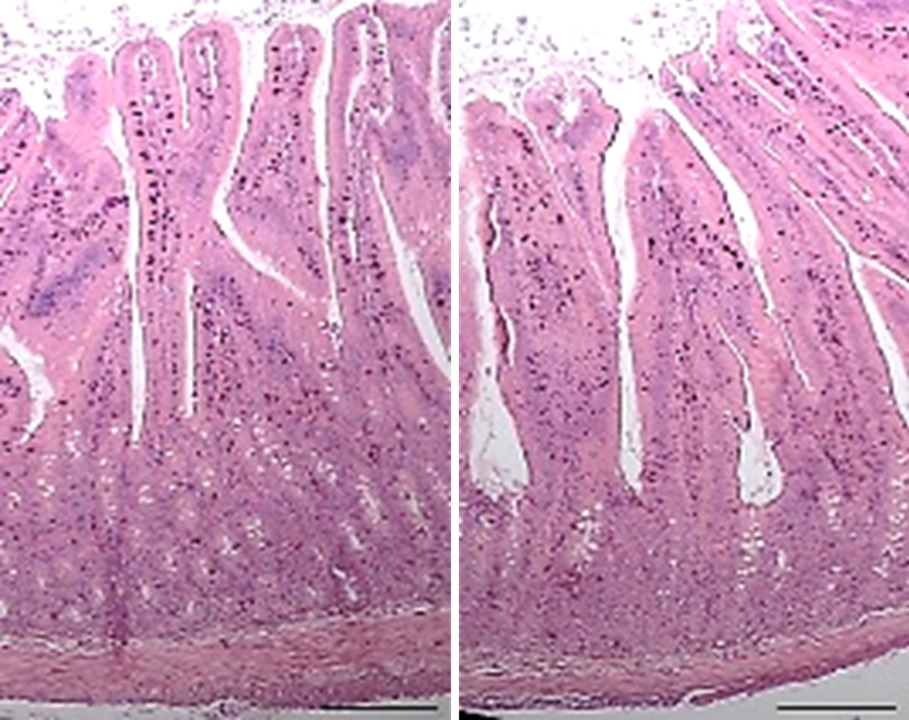Effect of subacute administration of orange juice (Citrus sinensis) on duodenal structure in paediatric Sprague-Dawley rats (Rattus novergicus)
Abstract
This research investigates the impact of orange juice consumption on the histological structure of the duodenum, a critical site for nutrient absorption and digestion. Focusing on pediatric animals, orange juice (with a pH of 3) was administered to post-weaning rats aged 4 weeks to 6 weeks at dosages ranging from 0g/kg BW to 20g/kg BW over two weeks. Duodenal histopathology was assessed, focusing on parameters such as the quantity of crypts of Lieberkuhn, as well as the length, height, width, and depth of villi (measured in μm). Anatomical pathology examination included measurements of the length and width of the duodenum (also in μm), as well as the color mean (OD). The research findings indicate no significant changes in histo-pathology or anatomy pathology of the duodenum. This suggests that young individuals can adapt to acidic challenges without compromising gastrointestinal health. These findings offer reassurance regarding the short-term consumption of acidic orange juice (with a pH of 3) with minimal risks to intestinal integrity, both during growth and development.
Downloads
References
[BPOM] Badan Pengawas Obat dan Makanan. 2022. Peraturan Kepala Badan Pengawas Obat dan Makanan Nomor 7 Tahun 2022 tentang Pedoman Uji Toksisitas Nonklinik secara In Vivo. Jakarta: BPOM.
Azzini E, Venneria E, Ciarapica D, Foddai MS, Intorre F, Zaccaria M, Maiani F, Palomba L, Barnaba L, Tubili C, Maiani G. 2017. Effect of red orange juice consumption on body composition and nutritional status in overweight/obese female: a pilot study. Oxidative Medicine and Cellular Longevity. 2017(1):1672567. https://doi.org/10.1155/2017/1672567
Beasley DE, Koltz AM, Lambert JE, Fierer N, Dunn RR. 2015. The evolution of stomach acidity and its relevance to the human microbiome. PloS one. 10(7):e0134116. https://doi.org/10.1371/journal.pone.0134116
Celi P, Cowieson AJ, Fru-Nji F, Steinert RE, Kluenter AM, Verlhac V. 2017. Gastrointestinal functionality in animal nutrition and health: new opportunities for sustainable animal production. Animal Feed Science and Technology. 234:88-100. https://doi.org/10.1016/j.anifeedsci.2017.09.012
Farrell RJ, Kelly CP. 2002. Celiac sprue. New England Journal of Medicine. 346(3):180-188. https://doi.org/10.1056/NEJMra010852
Gebishu M, Fikadu B, Bekele B, Tesfaye Jule L, N N, Ramaswamy K. 2022. Fluorescence and UV/visible spectroscopic investigation of orange and mango fruit juice quality in case of Adama Town. Scientific Reports. 12(1):7345. https://doi.org/10.1038/s41598-022-11471-7
Gelberg H. 2018. Pathophysiological mechanisms of gastrointestinal toxicity. Comprehensive Toxicology. 2018:139. https://doi.org/10.1016/B978-0-12-801238-3.10923-7
Kim JE, Lee MR, Park JJ, Choi JY, Song BR, Son HJ, Choi YW, Kim KM, Hong JT, Hwang DY. 2018. Quercetin promotes gastrointestinal motility and mucin secretion in loperamide-induced constipation of SD rats through regulation of the mAChRs downstream signal. Pharmaceutical biology. 56(1):309-317. https://doi.org/10.1080/13880209.2018.1474932
Momoh AO, Loyibo E. 2021. The evaluation of the effects of orange juice on the microflora, haematology and selected organs of albino rats. Journal of Probiotics & Health. 9(1):230.
Porter EM, Bevins CL, Ghosh D, Ganz T. 2002. The multifaceted Paneth cell. Cell and Molecular Life Sciences. 59:156-170. https://doi.org/10.1007/s00018-002-8412-z
Shaker A, Rubin DC. 2010. Intestinal stem cells and epithelial-mesenchymal interactions in the crypt and stem cell niche. Transla-tional Research. 156(3):180-187. https://doi.org/10.1016/j.trsl.2010.06.003
Simon Á, Gulyás G, Mészár Z, Bhide M, Oláh J, Bai P, Csősz É, Jávor A, Komlósi I, Remenyik J, Czeglédi L. 2019. Proteomics alterations in chicken jejunum caused by 24 h fasting. PeerJ. 7:e6588. https://doi.org/10.7717/peerj.6588

Copyright (c) 2024 CC-BY-SA

This work is licensed under a Creative Commons Attribution-ShareAlike 4.0 International License.
Authors who publish with this journal agree to the following terms:
1. Authors retain copyright and grant the journal right of first publication with the work simultaneously licensed under a Creative Commons Attribution License that allows others to share the work with an acknowledgement of the work's authorship and initial publication in this journal.
2. Authors are able to enter into separate, additional contractual arrangements for the non-exclusive distribution of the journal's published version of the work (e.g., post it to an institutional repository or publish it in a book), with an acknowledgement of its initial publication in this journal.
3. Authors are permitted and encouraged to post their work online (e.g., in institutional repositories or on their website) prior to and during the submission process, as it can lead to productive exchanges, as well as earlier and greater citation of published work (See The Effect of Open Access).

.jpg)















